At dusk, a small bird with enchanting black eyes, perched on a tiny branch, elegantly and leisurely plumbs its wings.
It did not seem to mind that a little more than 10 metres away, several people were excitedly watching it through telescopes and binoculars.
“This is the band-billed crake, remember the dark red colour of its feathers and the white bands on its belly,” whispered Gerold Dobler, an ornithologist from Austria.
“It’s so rare it is listed in the red data-book of endangered bird species.”
Everyone was so busy catching a glimpse of the rare crake, a fine reward for their hours of waiting, that they almost ignored the black-crowned night herons flying over their heads, or the agile swallows chasing insects above the low bushes.
Just 100 metres east of the woods, the ocean waves roll in and out. More than 10 species of shore birds enjoy the sea breeze and a tasty meal of crab.
“The crake added a new name to my birding checklist,” said Zhong Jia, aged about 50, who came from People’s Daily and started to joined bird watching groups three years ago.
“The number of rare birds I’ve seen has increased to 270 in the past three years and my personal goal is to reach 300 this year,” she said.
The nine-person bird watching team was mostly composed of Chinese journalists who had just finished covering the 23rd World Ornithological Congress in Beijing,which was held two weeks ago.
Happy Island
The peaceful place the avid bird watchers chose for their post-congress adventure is called Happy Island.
Situated in Laoting County of North China’s Hebei Province, it is only a three-hour drive from Beijing and about 80 kilometres south of another famous bird watching place in China – Beidaihe.
Beidaihe won world recognition as a birding haven during the 1999 Sky and Ocean International Bird Watching Race, which attracted nearly 200 Chinese and overseas bird watchers.
Best-known as a summer resort for its beaches, Beidaihe is home to tens of thousands of vacationers between July and September each year.
“Compared to Beidaihe, Happy Island seems much more lucky,” Zhong said, “because it is almost a pure paradise solely for birds and with little disturbance from tourists.”
Happy Island’s name came from Martin Williams, a British man who has been studying birds in the Beidaihe area since 1985.
He chanced upon the island in 1987 and his eyes kept on opening as wide as they could during the whole trip, recalled Xu Xiaohong, director of the Beidaihe Convalescence and Tourism Administration, who accompanied Williams to the island.
Xu said Williams found the island was entirely free human activities, although it is located just a few kilometres from the mainland.
Being a great island for birds, ornithologists and bird watchers, its name was a logical choice.
From then on, international bird watchers flocked in spring and autumn to the tiny island, which is 2 kilometres long and 1 kilometre wide, as it played host to numerous migrating birds, mainly shuttling between Siberia and South China.
The island’s name then spread rapidly among bird watchers worldwide, who gave it the Chinese name of Kuaile Dao.
Only locals still call it by its original Chinese name, Shijiu Tuo.
Situated between Bohai Bay to the east and the Yanshan Mountain Range to the west, the island provides feathered travellers with a resting place.
While there are more than 9,000 species of birds in the world, 1,200 can been seen in China and about 400 have been spotted at Beidaihe. “The number on Happy Island will be about the same due to its proximity to Beidaihe and their similar geographical conditions,” according to Dobler.
“It is one of the best places for bird watching in East Asia.
“The varying geographical conditions and changing weather brings different birds everyday, that is part of the fun for bird watchers.”
Connecting birds
Except for Dobler, Zhong and Yu Haiyan from Guangzhou TV Station, located in South China’s Guangdong Province, most team members were beginners in birding, so a short training course was necessary.
Zhong was appointed as the teacher. She said a telescope, binoculars and an illustrated bird book were all requirements for bird-watching. And to avoid disturbing the birds, bright-colour clothing is not allowed.
“Although it is the hottest days in the area, long-sleeve shirts, long trousers and gallons of insect repellent are strongly recommended because during the whole season, the island is alive with mosquitoes,” Zhong said.
“Early morning is a good time for bird watching, when the birds are busy feeding.”
So the island trip started at 7:30 am with a 5-minute ride on a small speedboat.
The sanctuary is covered with shrubs, reeds and a scattering of bushes, crossed by small tracks. Due to its small size, a bird watcher can easily cover the island on foot.
The welcoming bird was a brown shrike, quietly sitting on top of some bushes. Dobler explained that it was waiting for chances to catch its insect breakfast at lightening speed, after it spotted one.
Having been to the island several times, Zhong suggested that the members go through a small wooded area. It was a shortcut to get to the beach and a good place to find forest birds.
But mosquitoes came before the birds, dozens of them rushed to the intruders’ legs, arms and even faces. Although protected by clothes and insect repellent, no one emerged from the woods unbitten.
But the small group quickly put aside the uncomfortableness caused by the insects after Yu Haiyan spotted a small dark-green bird in the branches of a fir.
Everyone fixed their telescope on the tree and no one spoke.
The silence was broken by a small dispute over the name of the bird until Dobler whispered to the group that it was an arctic warbler, identifiable by its white, long and thin brow lines and distinctive chirping.
To get to the beach before the tide had ebbed too far out, taking all of the shore birds, the team decided to leave the mosquito and spider-web-ridden area and rush to the shore.
But the original shortcut was stopped by noisy human construction.
Workers pointed out the right way and explained that they were repairing an old temple, which was expected to attract more tourists besides bird watchers.
“It shows that the value of the place is obviously unknown to the local people,” Zhong sighed.
Luckily, shore birds such as dunlins, gulls and plovers seemed undaunted by the construction noise.
They peacefully gathered around, catching food or resting.
Dobler explained the difference between various species of dunlins and plovers and how to spot them by distinguishing between the length of their beaks, body size and the colour of their claws.
“Most birds are molting in preparation for winter so it’s harder to identify them than in spring,” Dobler said.
Most of the team were busy checking the guide book after finding a new species, in an effort to find its name and body characteristics.
They were excited to find out they could accurately distinguish between eastern and Eurasian curlews and Asian dowitchers.
Not satisfied with watching birds through telescopes, Ding even took off his shoes to walk into the mud to gain a closer look.
Maybe because he moved so slowly the birds felt he meant no harm – they did not fly away even when he stopped less than 10 metres away.
Yu was pleased to add so many new birds to her watching list, most of which she had no chance of seeing in her hometown in South China’s Guangdong Province.
The joy overcame her weariness after carrying the same heavy equipment as the men, a binocular to search for the animals and a half-metre-long telescope for catching close-ups.
Yu said she began to watch birds in her childhood because one of her neighbours was a university biology teacher.
The neighbour taught Yu how to watch birds in their natural environment, to find differences in their behaviour and most importantly, to love and protect them.
“Birds are friends of humans,” Yu said.
“They are connected with us in nature.”
Join the group
Zhong regretted that although China is one of the countries gifted with a rich bird life, the number of people appreciating its beauty is still small.
There is only about 100 people regularly taking part in birding trips around the country.
“I believe the number will increase rapidly as more and more people recognize the fun of it,”Zhong said.
She said most trips were organized by the Friends of Nature and the Green Earth Volunteers, two environmental non-government organizations based in Beijing. There is also a regular training course given by Zhao Xinru, a biologist from Beijing Normal University, every Wednesday evening at the university.
The bird watchers, most of whom are students and professors who study birds, exchanged their experiences during the breaks.
And through the Internet, bird watchers from Xiamen, in East China’s Fujian Province, South China’s Guangdong Province and the Beijing and Shanghai municipalities share new findings, questions and answers.
“Birds are everywhere around us, in the parks, on the windows, above the antennae,” Zhong said.
“Holding binoculars is no harder than holding a camera. Bird watching offers a good chance to think about ourselves.
“Humans and birds used to be harmonious. It’s humans who destroyed the harmony and we should stop right now.”
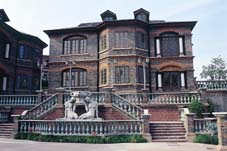 The Zhenjiang Museum, constructed in 1958, consists of a group of five East Indian garden style buildings. It houses more than 30,000 Chinese historical relics, from the Neolithic Age to the Qing Dynasty (1644-1911), and over 100,000 ancient books. Among them are one national treasure, and some 70 first class national cultural relics. The museum’s main exhibits are Western Zhou Dynasty (c.11th century-771 B.C.) bronze wares, celadon from the Six Dynasties (220-589), gold and silver wares from the Tang, Song, Yuan and Ming dynasties, and works of calligraphy and paintings from the Ming and Qing dynasties. These exhibits constitute a tribute to the history of this ancient east China town.
The Zhenjiang Museum, constructed in 1958, consists of a group of five East Indian garden style buildings. It houses more than 30,000 Chinese historical relics, from the Neolithic Age to the Qing Dynasty (1644-1911), and over 100,000 ancient books. Among them are one national treasure, and some 70 first class national cultural relics. The museum’s main exhibits are Western Zhou Dynasty (c.11th century-771 B.C.) bronze wares, celadon from the Six Dynasties (220-589), gold and silver wares from the Tang, Song, Yuan and Ming dynasties, and works of calligraphy and paintings from the Ming and Qing dynasties. These exhibits constitute a tribute to the history of this ancient east China town.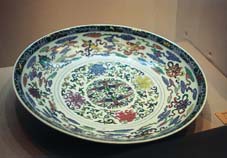 Plate with polychrome design of phoenix and the eight Buddhist emblems (Qing Dynasty).
Plate with polychrome design of phoenix and the eight Buddhist emblems (Qing Dynasty).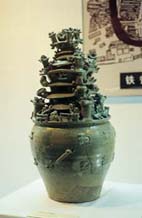 Celadon jar with modeled acrobatic figures and winged bird (Wu State of Three Kingdoms).
Celadon jar with modeled acrobatic figures and winged bird (Wu State of Three Kingdoms).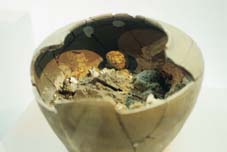 Primitive porcelain pot with eggs inside (Spring and Autumn Period).
Primitive porcelain pot with eggs inside (Spring and Autumn Period).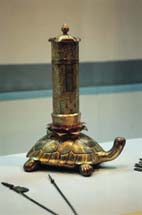 Gilt silver tortoise carrying a candle-shaped tube with inscriptions of “The Analects of Confucius” (Tang Dynasty).
Gilt silver tortoise carrying a candle-shaped tube with inscriptions of “The Analects of Confucius” (Tang Dynasty). This small city in the craggy mountains north of Beijing used to shelter Qing Dynasty notables (including the empress dowager Ci Xi), from Beijing’s summer heat. The inner city is like something fresh out of the mountains, and most of the locals have seldom seen foreigners. But the city is surrounded by things for travelers to see: the Emperor’s Summer Mansion, Buddhist Temples and hills to climb. It’s also, on average, cooler than Beijing in the summer.
This small city in the craggy mountains north of Beijing used to shelter Qing Dynasty notables (including the empress dowager Ci Xi), from Beijing’s summer heat. The inner city is like something fresh out of the mountains, and most of the locals have seldom seen foreigners. But the city is surrounded by things for travelers to see: the Emperor’s Summer Mansion, Buddhist Temples and hills to climb. It’s also, on average, cooler than Beijing in the summer.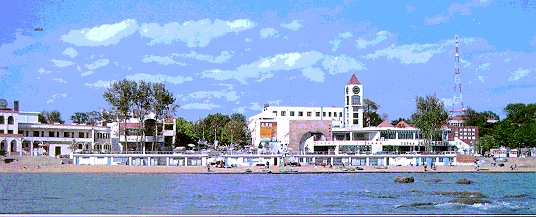 Situated at the foot of Yanshan Mountain, facing the Bohai Sea, Qinhuangdao is famous for its ice-free harbour, the summer resort Beidaihe and the First Pass Under Heaven.Qinhuangdao was approved by the State Council in April 1984 as one of the 14 coastal cities that were opened furth to the outside world. The spring wind of reform and opening changes Qinhuangdao day after day, attracking attention from the people of the world.
Situated at the foot of Yanshan Mountain, facing the Bohai Sea, Qinhuangdao is famous for its ice-free harbour, the summer resort Beidaihe and the First Pass Under Heaven.Qinhuangdao was approved by the State Council in April 1984 as one of the 14 coastal cities that were opened furth to the outside world. The spring wind of reform and opening changes Qinhuangdao day after day, attracking attention from the people of the world.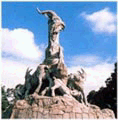 Guangzhou has a few beautiful and legendary nick names, Huacheng (the Flower City), Yangcheng (the Goat City) and Suicheng (the Rice-ear City). Guangzhou is a civilized ancient city. It is 2,100 years old, the same ages as the world-renowned ancient cultural city Rome of Italy. A modern city in China, Guang-zhou is the political, economic, edu-cational, cultural as well as scientific and technological center in South China. It is also a tourist city. Being a big city, Guangzhou totals 7475 square kilometers with a popu-lation of some 6.56 million.
Guangzhou has a few beautiful and legendary nick names, Huacheng (the Flower City), Yangcheng (the Goat City) and Suicheng (the Rice-ear City). Guangzhou is a civilized ancient city. It is 2,100 years old, the same ages as the world-renowned ancient cultural city Rome of Italy. A modern city in China, Guang-zhou is the political, economic, edu-cational, cultural as well as scientific and technological center in South China. It is also a tourist city. Being a big city, Guangzhou totals 7475 square kilometers with a popu-lation of some 6.56 million. 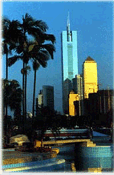 Under its administration are four county-level cities of Huadu, Conghua, Zengcheng and Panyu and eight districts: Yuexiu, Dongshan, Haizhu, Litchi, Tianhe, Baiyun, Fangcun and Whampu. It is a well-known hometown of the overseas Chinese. About 500,000 countrymen from here are residing in some 90 countries and regions abroad.
Under its administration are four county-level cities of Huadu, Conghua, Zengcheng and Panyu and eight districts: Yuexiu, Dongshan, Haizhu, Litchi, Tianhe, Baiyun, Fangcun and Whampu. It is a well-known hometown of the overseas Chinese. About 500,000 countrymen from here are residing in some 90 countries and regions abroad.  Guangzhou is situated in the south of China with the Baiyun Hill in the north and the Zhujiang (the Pearl River) Delta Plain in front, Three rivers, the Dong-jiang, Xijiang and Beijiang converge here. The Zhujiang passes through the city. With rivers and mountains,its geological location is very advantageous.
Guangzhou is situated in the south of China with the Baiyun Hill in the north and the Zhujiang (the Pearl River) Delta Plain in front, Three rivers, the Dong-jiang, Xijiang and Beijiang converge here. The Zhujiang passes through the city. With rivers and mountains,its geological location is very advantageous.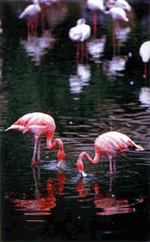 Xiangjiang Wildlife World: A lively world in Panyu with about 10,000 animals in 300 species introduced from all over the world. Many are rare animals that have never seen before in China. It is divided into vehicle tour area and walking-appreciating area. Here, visitors may stroll in different ecological environments, contacting with the vital nature and wildlife in natural state.
Xiangjiang Wildlife World: A lively world in Panyu with about 10,000 animals in 300 species introduced from all over the world. Many are rare animals that have never seen before in China. It is divided into vehicle tour area and walking-appreciating area. Here, visitors may stroll in different ecological environments, contacting with the vital nature and wildlife in natural state.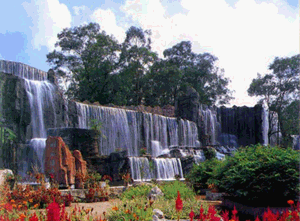 Litai Waterfall: Located in Panyu, the waterfall is 138 meters wide with a difference of 28 meters.The scenic area is covered with dense and greed trees. There are sea world, exciting animal performances and a few other amusements.
Litai Waterfall: Located in Panyu, the waterfall is 138 meters wide with a difference of 28 meters.The scenic area is covered with dense and greed trees. There are sea world, exciting animal performances and a few other amusements.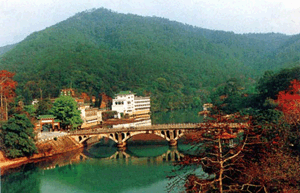 Conghua Hot Springs Scenic Region: It was first built in Ming and Qing Dynasties. It is the famous Second Radou Spring of the world. The water, colorless and odorless, contains numerous elements good for health. The springs are surrounded by undulating mountains. It is full of idyllic flavor with the green mountains and blue water.
Conghua Hot Springs Scenic Region: It was first built in Ming and Qing Dynasties. It is the famous Second Radou Spring of the world. The water, colorless and odorless, contains numerous elements good for health. The springs are surrounded by undulating mountains. It is full of idyllic flavor with the green mountains and blue water.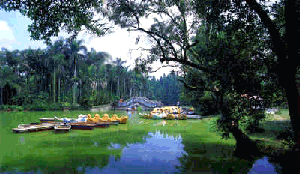 South China Botanic Garden: Situated at Longdong in the northeast suburbs of Guangzhou in a beautiful environment, it is one of top ten tourist attractions in Guangzhou and the largest south Asia tropical botanic garden in China as well. The botanic garden has more than 5,000 species of plants introduced from home and abroad. It owns a collection of palm, bamboo, orchid, pteridophyte and shade plants.
South China Botanic Garden: Situated at Longdong in the northeast suburbs of Guangzhou in a beautiful environment, it is one of top ten tourist attractions in Guangzhou and the largest south Asia tropical botanic garden in China as well. The botanic garden has more than 5,000 species of plants introduced from home and abroad. It owns a collection of palm, bamboo, orchid, pteridophyte and shade plants. Purple Horse Hill Park is located in the south of Zhongshan 3rd Road, covering an area of 88.5 hectares. The Municipality of Zhongshan invested 160 thousand RMB yuan in the building of this park in 1992 and it was open to tourists on the National Day of 1993.
Purple Horse Hill Park is located in the south of Zhongshan 3rd Road, covering an area of 88.5 hectares. The Municipality of Zhongshan invested 160 thousand RMB yuan in the building of this park in 1992 and it was open to tourists on the National Day of 1993.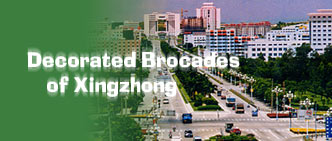 Xingzhong Road is one of the Ten Scenic Spots in Zhongshan, nicknamed “Decorated Brocades of Xingzhong.”
Xingzhong Road is one of the Ten Scenic Spots in Zhongshan, nicknamed “Decorated Brocades of Xingzhong.”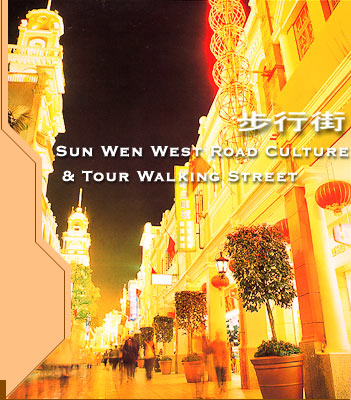 This street has a history of over a hundred years and its predecessor was the commercial center for the old city with bustling shops and people. There is the oldest medicine shop – Fushou Drugstore. It was created in the first year of Tongzhi Reign of the Qing Dynasty (1862) named “Liang & Li” at first and was changed to this name by its creator, Li Ruiwen. There is the old 5-story Yong’an Company Branch. Yong’an Company was one of the big 4 department stores at the beginning of the 20th century created by the Guo Brothers of Elegant Bamboo Village of Xiangshan County (the predecessor of Zhongshan City) with its base in Hong Kong in 1907, succeeding the former Sydney Yong’an (1897). In February 1929, the Guo Brothers opened their branch here. Along the walk there are many buildings such as Shiqi Hotel (the former Sihao Hotel), and British-style and Southeastern Asian-style buildings, steeped with many legends and stories.
This street has a history of over a hundred years and its predecessor was the commercial center for the old city with bustling shops and people. There is the oldest medicine shop – Fushou Drugstore. It was created in the first year of Tongzhi Reign of the Qing Dynasty (1862) named “Liang & Li” at first and was changed to this name by its creator, Li Ruiwen. There is the old 5-story Yong’an Company Branch. Yong’an Company was one of the big 4 department stores at the beginning of the 20th century created by the Guo Brothers of Elegant Bamboo Village of Xiangshan County (the predecessor of Zhongshan City) with its base in Hong Kong in 1907, succeeding the former Sydney Yong’an (1897). In February 1929, the Guo Brothers opened their branch here. Along the walk there are many buildings such as Shiqi Hotel (the former Sihao Hotel), and British-style and Southeastern Asian-style buildings, steeped with many legends and stories. It is said that more than 300 years ago, an uncle and nephew with the family name of Long trekked a long way from Jiangxi Province to this place to clear land. To commemorate their hometown they named the place in which they were to live “Long Range” (They walked up and down a long range when they came here). Later they changed the name to “Long River,” for the two Chinese characters for “range” and “river” have the same pronunciation in Jiangxi dialect, meaning that they had lived in Jiangxi Province since their ancestors. It was how this name originated.
It is said that more than 300 years ago, an uncle and nephew with the family name of Long trekked a long way from Jiangxi Province to this place to clear land. To commemorate their hometown they named the place in which they were to live “Long Range” (They walked up and down a long range when they came here). Later they changed the name to “Long River,” for the two Chinese characters for “range” and “river” have the same pronunciation in Jiangxi dialect, meaning that they had lived in Jiangxi Province since their ancestors. It was how this name originated.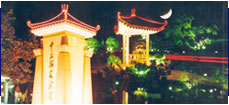 Zhongshan Hot Spring is located in Yongmo Village, Sanxiang Town, Zhongshan City. It adjoins Hong Kong and Macao and is 26 kilometers away from Zhuhai, 24 kilometers from Shiqi downtown, and 10 kilometers from the Former Residence of Sun Yat-Sen.
Zhongshan Hot Spring is located in Yongmo Village, Sanxiang Town, Zhongshan City. It adjoins Hong Kong and Macao and is 26 kilometers away from Zhuhai, 24 kilometers from Shiqi downtown, and 10 kilometers from the Former Residence of Sun Yat-Sen.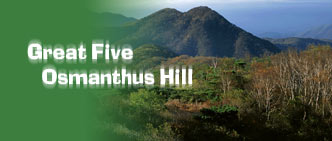 Great Five Osmanthus Hill is both an old scenic spot and one enlisted in the “New Scenic Spots of Zhongshan City.” There are soaring peaks, unique flowers and exotic plants, the new look of development, touching folk tales, and the most stirring – the moving stories of the revolutionaries fighting the enemies.
Great Five Osmanthus Hill is both an old scenic spot and one enlisted in the “New Scenic Spots of Zhongshan City.” There are soaring peaks, unique flowers and exotic plants, the new look of development, touching folk tales, and the most stirring – the moving stories of the revolutionaries fighting the enemies.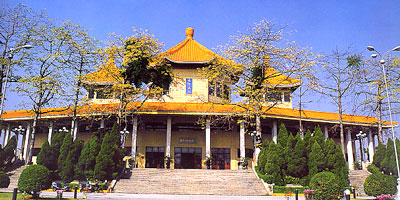 There are many memorial halls in China and that at the foot of Mount Yuexiu in Guangzhou is a world famous shrine of culture in history. Besides that, the other famous ones include those at the Fragrant Hill of Beijing, Wuzhou of the Guangxi Zhuang Autonomous Region, Haikou of Hainan Province, and Meizhou of Guangdong Province. The Memorial Hall of Sun Yat-sen is not only a memorial hall for Sun Yat-sen but the second largest after that in Guangzhou City.This hall is located at Sunwen Middle Road of Zhongshan City, taking a conspicuous place, betraying the local people’s exceptional love for him.
There are many memorial halls in China and that at the foot of Mount Yuexiu in Guangzhou is a world famous shrine of culture in history. Besides that, the other famous ones include those at the Fragrant Hill of Beijing, Wuzhou of the Guangxi Zhuang Autonomous Region, Haikou of Hainan Province, and Meizhou of Guangdong Province. The Memorial Hall of Sun Yat-sen is not only a memorial hall for Sun Yat-sen but the second largest after that in Guangzhou City.This hall is located at Sunwen Middle Road of Zhongshan City, taking a conspicuous place, betraying the local people’s exceptional love for him. In Cuiheng Village, Nanlang Town of Zhongshan City, there is the internationally well known Sun Yat-sen’s Former Residence, a sanctuary appealing to passengers. This village is only 25 kilometers far from the city and 37 kilometers from Macao.
In Cuiheng Village, Nanlang Town of Zhongshan City, there is the internationally well known Sun Yat-sen’s Former Residence, a sanctuary appealing to passengers. This village is only 25 kilometers far from the city and 37 kilometers from Macao.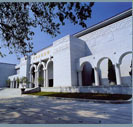 This village is renowned internationally not only for its beautiful landscape, but also for the sake that it has Sun Yat-sen’s birthplace. Here is an ember two-story building characterized by both Chinese and western styles, the former residence of Mr. Sun Yat-sen.
This village is renowned internationally not only for its beautiful landscape, but also for the sake that it has Sun Yat-sen’s birthplace. Here is an ember two-story building characterized by both Chinese and western styles, the former residence of Mr. Sun Yat-sen.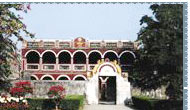 On 12 November 1866, Sun Yat-sen was born here and this house was originally a farm bungalow covering only 30 square meters. In 1982, Sun Yat-sen’s brother Sun Mei, a businessman in Honolulu sent money to his home,and Sun Yat-sen, who was having his studies in Hong Kong Medical School designed and built the current building. On the right hand of the facade outside the wall, there is a stone plaque written by Song Qingling, which reads, “Sun Yat-sen’s Former Residence” in Chinese. Inside the wall, there is a hawthorn planted by Mr. Sun Yat-sen, luxuriant and tough though lying prostrate on the ground due to a typhoon. Guo Moluo, a distinguished Chinese scholar wrote a line of verse “a dragon of hawthorn” at the sight of the unique form of this tree when he toured this place. The bearing of the tree conjures up rich imagination. On both sides of the gate, there is a couplet composed and written by Mr. Sun, which reads “A rafter is enough for my residence/Trees accompany me.” On the right of thehouse, there lies a well, by which Sun Yat-sen was born. The middle room of the first floor is the hall, laid out as it was. Further deep was the bedroom for Mr. Sun’s mother. On the left side of the hall was the bedroom for Lu Muzhen, Sun Yat-sen’s first wife while on the right was the bedroom for Sun Yat-sen’s brother Sun Mei and the latter’s wife. The middle room of the second room has been empty and in the back of it is a shrine, both sides of which are respectively Sun’s study and a guestroom.
On 12 November 1866, Sun Yat-sen was born here and this house was originally a farm bungalow covering only 30 square meters. In 1982, Sun Yat-sen’s brother Sun Mei, a businessman in Honolulu sent money to his home,and Sun Yat-sen, who was having his studies in Hong Kong Medical School designed and built the current building. On the right hand of the facade outside the wall, there is a stone plaque written by Song Qingling, which reads, “Sun Yat-sen’s Former Residence” in Chinese. Inside the wall, there is a hawthorn planted by Mr. Sun Yat-sen, luxuriant and tough though lying prostrate on the ground due to a typhoon. Guo Moluo, a distinguished Chinese scholar wrote a line of verse “a dragon of hawthorn” at the sight of the unique form of this tree when he toured this place. The bearing of the tree conjures up rich imagination. On both sides of the gate, there is a couplet composed and written by Mr. Sun, which reads “A rafter is enough for my residence/Trees accompany me.” On the right of thehouse, there lies a well, by which Sun Yat-sen was born. The middle room of the first floor is the hall, laid out as it was. Further deep was the bedroom for Mr. Sun’s mother. On the left side of the hall was the bedroom for Lu Muzhen, Sun Yat-sen’s first wife while on the right was the bedroom for Sun Yat-sen’s brother Sun Mei and the latter’s wife. The middle room of the second room has been empty and in the back of it is a shrine, both sides of which are respectively Sun’s study and a guestroom. It was in the predecessor of this house that Sun Yat-sen spent his boyhood. Between 1892 and 1895, Sun had his pre-career three years when he treated his country folks for their diseases, and read books about history and politics to seek approaches and truth saving the people in a dire crisis. Here he wrote his To Li Hongzhang (a Prime Minister of the Qing Dynasty) to show his patriotic concern for his country and people. Here, he and his close friend Lu Haodong made their “Recovery of China” anti-Qing-Dynasty plan.
It was in the predecessor of this house that Sun Yat-sen spent his boyhood. Between 1892 and 1895, Sun had his pre-career three years when he treated his country folks for their diseases, and read books about history and politics to seek approaches and truth saving the people in a dire crisis. Here he wrote his To Li Hongzhang (a Prime Minister of the Qing Dynasty) to show his patriotic concern for his country and people. Here, he and his close friend Lu Haodong made their “Recovery of China” anti-Qing-Dynasty plan.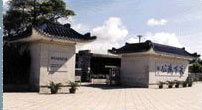 In the northwest of the residence, there was built a “Exhibition Hall for Sun Yat-sen’s Former Residence” and “Studio for Speeches Made by Sun Yat-sen,” where precious historical films on him and records about his re-interpretations about the Three Principles of the People in 1924.
In the northwest of the residence, there was built a “Exhibition Hall for Sun Yat-sen’s Former Residence” and “Studio for Speeches Made by Sun Yat-sen,” where precious historical films on him and records about his re-interpretations about the Three Principles of the People in 1924.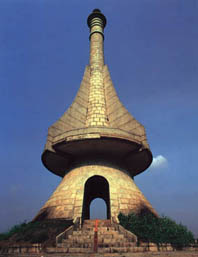 GUANGDONG is contiguous to Hong Kong and Macao, and neighbors Southeast Asia. Its advantageous geographical location makes it the window through which China and the rest of the world communicates.
GUANGDONG is contiguous to Hong Kong and Macao, and neighbors Southeast Asia. Its advantageous geographical location makes it the window through which China and the rest of the world communicates. Yet-sen, Mao Zedong, Zhou Enlai, and Liao Zhongkai, were once active in Guangdong leaving behind many sites of historic and revolutionary significance. In the 1980s, when China entered a new era, it was Guangdong, the pioneer province, that put into practice the reform and opening policy, and once again stunned the world with its great achievements in economic development.
Yet-sen, Mao Zedong, Zhou Enlai, and Liao Zhongkai, were once active in Guangdong leaving behind many sites of historic and revolutionary significance. In the 1980s, when China entered a new era, it was Guangdong, the pioneer province, that put into practice the reform and opening policy, and once again stunned the world with its great achievements in economic development.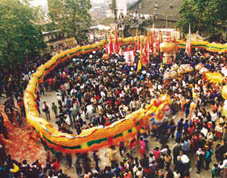 Guangdong is located along the subtropical belt, giving it a pleasant climate, suitable for tourism all year round. Guangdong has something for everyone who passes through its borders. Those seeking places of historic interest may visit the relics of “Mapa man” and the ancient Nanyue kingdom. The six cities of Guangzhou, Foshan, Chaozhou, Meizhou, Zhaoqing, and Leizhou are also famous for their cultural and historic sites.
Guangdong is located along the subtropical belt, giving it a pleasant climate, suitable for tourism all year round. Guangdong has something for everyone who passes through its borders. Those seeking places of historic interest may visit the relics of “Mapa man” and the ancient Nanyue kingdom. The six cities of Guangzhou, Foshan, Chaozhou, Meizhou, Zhaoqing, and Leizhou are also famous for their cultural and historic sites.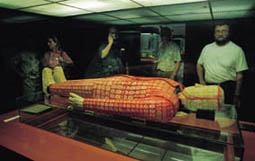 In recent years, Guangdong has constructed a number of new scenic spots in contemporary style, such as Miniature China, the Chinese Folk Culture Village, the New Yuanming Garden, the Xiangjiang River Wild Animal World, the Changlong Wild Nocturnal Animal World, Baomo Garden, the Huang Feihong Lion Dance Art Gallery, the Green World, and the Yannanfei Tea Garden. These places combine pleasure with knowledge acquisition, and consequently attract countless visitors.
In recent years, Guangdong has constructed a number of new scenic spots in contemporary style, such as Miniature China, the Chinese Folk Culture Village, the New Yuanming Garden, the Xiangjiang River Wild Animal World, the Changlong Wild Nocturnal Animal World, Baomo Garden, the Huang Feihong Lion Dance Art Gallery, the Green World, and the Yannanfei Tea Garden. These places combine pleasure with knowledge acquisition, and consequently attract countless visitors.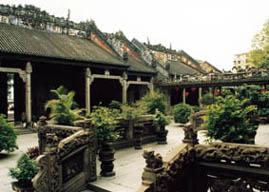 To make visits to Guangdong via Hong Kong and Macao more convenient for foreigners, in 2000 the Chinese State Council extended the 72 hour transit visa procedure, implemented in 1996, to 144 hours for foreign tourist groups organized in Hong Kong and Macao, and visiting Guangzhou, Shenzhen, Zhuhai, Zhongshan, Dongguan, Foshan, Jiangmen, Zhaoqing, and Shunde in the Zhujiang River Delta, as well as Shantou City. With its developed communications networks and an ideal environment for travel, Guangdong is doing its best to offer Chinese and overseas tourists the most pleasant, stimulating, and enjoyable holiday possible.
To make visits to Guangdong via Hong Kong and Macao more convenient for foreigners, in 2000 the Chinese State Council extended the 72 hour transit visa procedure, implemented in 1996, to 144 hours for foreign tourist groups organized in Hong Kong and Macao, and visiting Guangzhou, Shenzhen, Zhuhai, Zhongshan, Dongguan, Foshan, Jiangmen, Zhaoqing, and Shunde in the Zhujiang River Delta, as well as Shantou City. With its developed communications networks and an ideal environment for travel, Guangdong is doing its best to offer Chinese and overseas tourists the most pleasant, stimulating, and enjoyable holiday possible.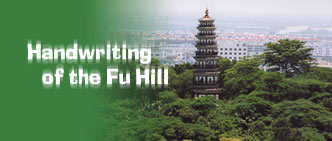 Study Tower is one of the 10 Scenic Spots in Zhongshan and it had been enlisted as one of the 8 Scenic Spots of Xiangshan in the Reign of Kangxi of the Qing Dynasty. It was built on a hilltop in Zhongshan Park and that makes it more typical of its local touch.
Study Tower is one of the 10 Scenic Spots in Zhongshan and it had been enlisted as one of the 8 Scenic Spots of Xiangshan in the Reign of Kangxi of the Qing Dynasty. It was built on a hilltop in Zhongshan Park and that makes it more typical of its local touch.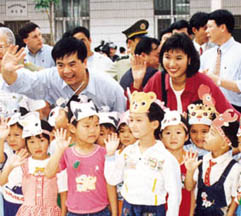 modernization. These cities are not far apart, and are connected by expressways, so it takes only one hour by air-conditioned bus to travel from one city to another. Inhabitants of Dongguan consequently enjoy spending their weekends in Zhuhai, and compatriots from Hong Kong and Macao come to tour Shenzhen, Zhuhai, Huizhou or Zhaoqing at weekends. Convenient transportation and developed facilities have enhanced the inflow of inhabitants. It is confidently predicted that in the near future the cities of the Zhujiang River Delta will be linked together as a whole.
modernization. These cities are not far apart, and are connected by expressways, so it takes only one hour by air-conditioned bus to travel from one city to another. Inhabitants of Dongguan consequently enjoy spending their weekends in Zhuhai, and compatriots from Hong Kong and Macao come to tour Shenzhen, Zhuhai, Huizhou or Zhaoqing at weekends. Convenient transportation and developed facilities have enhanced the inflow of inhabitants. It is confidently predicted that in the near future the cities of the Zhujiang River Delta will be linked together as a whole.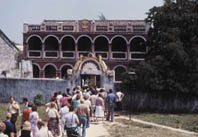 Shenzhen will continue to strengthen its functions in finance, foreign trade, commerce, and transfer of international trade. It will also develop an export-oriented economy featuring capital- and technology-intensive industries, to continue to serve as a window on reform and opening and as an experimental ground. In its functions it will gradually realize mutual complementation with Hong Kong, to develop into an international city of influential importance in the city group of the Zhujiang River Delta, and in the eastern area.
Shenzhen will continue to strengthen its functions in finance, foreign trade, commerce, and transfer of international trade. It will also develop an export-oriented economy featuring capital- and technology-intensive industries, to continue to serve as a window on reform and opening and as an experimental ground. In its functions it will gradually realize mutual complementation with Hong Kong, to develop into an international city of influential importance in the city group of the Zhujiang River Delta, and in the eastern area.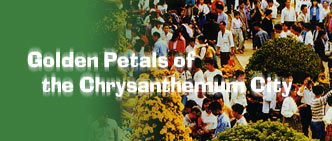 “Golden Petals of the Chrysanthemum City” is one of the “Ten Scenic Spots” of Zhongshan, referring to the petals in Xiaolan Town, Zhongshan City. Xiaolan people have kept their practice of flower cultivation for several hundred years. From end to end of each street, from the courtyard to the flowerbed, from the balcony to the roof of each household, a wide range of chrysanthemum varieties prevail. Whenever the golden fall comes, the colorful chrysanthemums reign the whole town. The golden petals always take the dominance of their flower folks forming a chrysanthemum city of golden petals living up to its reality.
“Golden Petals of the Chrysanthemum City” is one of the “Ten Scenic Spots” of Zhongshan, referring to the petals in Xiaolan Town, Zhongshan City. Xiaolan people have kept their practice of flower cultivation for several hundred years. From end to end of each street, from the courtyard to the flowerbed, from the balcony to the roof of each household, a wide range of chrysanthemum varieties prevail. Whenever the golden fall comes, the colorful chrysanthemums reign the whole town. The golden petals always take the dominance of their flower folks forming a chrysanthemum city of golden petals living up to its reality. All these render an atmosphere of a fairyland. The architecture in the islet varies greatly in style, Chinese and foreign. Thus the islet has a laudatory title “the World Architecture Museum” The residents here love music very much, and the number of the pianos possessed is in the leading place in the nation, though there is only a population of 20,000 people. Thus the islet is praised as the “Piano Islet”. Today, Gulangyu is listed as one of the nation’s major scenic spot. The main sites of interest here include the Sunlit Rock, Shuzhuang Park, Gangzihou Bathing Beach and Memorial Hall to Zheng Chenggong, which are visited annually by millions of people from all parts of the country and the world. Sunlight Rock Riguang Rock is also called Yellow Rock. It is the summit of Gulang Islet. On the mountain, huge and precipitous rocks form many caves and gullies. Pavilions are hidden among green trees. If you go up the steps, you will come to the Lotus Flower Convent first, where a huge rock named ”A Piece of Tile”, sitting on the top, forms a hall below. On the large rocks beside the convent are inscribed ”Wonderland of Gulang,” and ”Number One along the Egret River.” Behind the convent are ”the Dragon’s Cave of the Egret River,” ”the Cave of Summer Resort,” and ther scenic spots.
All these render an atmosphere of a fairyland. The architecture in the islet varies greatly in style, Chinese and foreign. Thus the islet has a laudatory title “the World Architecture Museum” The residents here love music very much, and the number of the pianos possessed is in the leading place in the nation, though there is only a population of 20,000 people. Thus the islet is praised as the “Piano Islet”. Today, Gulangyu is listed as one of the nation’s major scenic spot. The main sites of interest here include the Sunlit Rock, Shuzhuang Park, Gangzihou Bathing Beach and Memorial Hall to Zheng Chenggong, which are visited annually by millions of people from all parts of the country and the world. Sunlight Rock Riguang Rock is also called Yellow Rock. It is the summit of Gulang Islet. On the mountain, huge and precipitous rocks form many caves and gullies. Pavilions are hidden among green trees. If you go up the steps, you will come to the Lotus Flower Convent first, where a huge rock named ”A Piece of Tile”, sitting on the top, forms a hall below. On the large rocks beside the convent are inscribed ”Wonderland of Gulang,” and ”Number One along the Egret River.” Behind the convent are ”the Dragon’s Cave of the Egret River,” ”the Cave of Summer Resort,” and ther scenic spots. 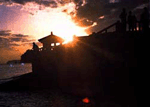 Close to the convent is the historical site of Zheng Chenggong’s Dragon Head Mountain Fastness and the platform for directing the raining of his seamen. Coming to the top of the mountain, you can see the beautiful views of the sea nd the mountains, and the Xiamen Island and Gulangyu, Dadan and Erdan are all presented before your eyes. Shuzhuang Park Shuzhuang Park is situated on the seashore to the south of Riguang Rock. In the 21st year of the Guangxu period in the Qing Dynasty (1895), a rich merchant from Tainan came to Gulangyu with his family and made his home there. He hegan building the park in 1913 in memory of his native home in Banqiao, Taiwan, and used Shuzhuang, the homonym of his mother’s name to name the park. Now a bronze statue of the former owner of the park stands in the park. Architecturally the park is very cleverly designed by taking advantage of the mountain and the sea. There you can feel a stillness in things moving, and a movement in things still. It presents such a unique scene that you might find it difficult to tear yourself avay from it. Inside the park there are several beautiful views such as Renqiu Pavilion, the Forty-four Bridge, the Piled-up Rocks, the artificial hills, Danying Veranda and the Insensate Rock Room. No wonder the park ranks first among the famous parks in Xiamen. To its left is Gangzihou bathing beach, which is marked by clear water and sand, and has the capacity of bathing thousands of people at a time. Nearby there is YanPing Park, which was set up in memory of Zheng Chenggong. The Nine-bending Forty-four Bridge is the major view of Shuzhuang Park. This over-one-hundred-metre-long bridge looks like a dragon moving through the water On the bridge there are Watching Fishing Stand, Ferrying-to-theMoon Pavilion, One-thousand-wave Pavilion and so on. If you are strolling about or taking a rest on the bridge when it is at full tide, You might have a feeling of walking on the sea, coming up and down with the waves. On the Piled-up Rocks by the ninding crossing-the-sea bridge are inscribed these words: “Vast Sea and Boundless Sky,” and ”Resting the Head on the Currents,” which are so beautifully written and so vividly blended with the surroundings that you would find them pleasing both to the eye and to the mind!
Close to the convent is the historical site of Zheng Chenggong’s Dragon Head Mountain Fastness and the platform for directing the raining of his seamen. Coming to the top of the mountain, you can see the beautiful views of the sea nd the mountains, and the Xiamen Island and Gulangyu, Dadan and Erdan are all presented before your eyes. Shuzhuang Park Shuzhuang Park is situated on the seashore to the south of Riguang Rock. In the 21st year of the Guangxu period in the Qing Dynasty (1895), a rich merchant from Tainan came to Gulangyu with his family and made his home there. He hegan building the park in 1913 in memory of his native home in Banqiao, Taiwan, and used Shuzhuang, the homonym of his mother’s name to name the park. Now a bronze statue of the former owner of the park stands in the park. Architecturally the park is very cleverly designed by taking advantage of the mountain and the sea. There you can feel a stillness in things moving, and a movement in things still. It presents such a unique scene that you might find it difficult to tear yourself avay from it. Inside the park there are several beautiful views such as Renqiu Pavilion, the Forty-four Bridge, the Piled-up Rocks, the artificial hills, Danying Veranda and the Insensate Rock Room. No wonder the park ranks first among the famous parks in Xiamen. To its left is Gangzihou bathing beach, which is marked by clear water and sand, and has the capacity of bathing thousands of people at a time. Nearby there is YanPing Park, which was set up in memory of Zheng Chenggong. The Nine-bending Forty-four Bridge is the major view of Shuzhuang Park. This over-one-hundred-metre-long bridge looks like a dragon moving through the water On the bridge there are Watching Fishing Stand, Ferrying-to-theMoon Pavilion, One-thousand-wave Pavilion and so on. If you are strolling about or taking a rest on the bridge when it is at full tide, You might have a feeling of walking on the sea, coming up and down with the waves. On the Piled-up Rocks by the ninding crossing-the-sea bridge are inscribed these words: “Vast Sea and Boundless Sky,” and ”Resting the Head on the Currents,” which are so beautifully written and so vividly blended with the surroundings that you would find them pleasing both to the eye and to the mind! Xiamen City, as an adminis-trative unit, can be dated back as far as the Song Dynasty. It has always been an important trading port, but since its establish-ment as one of China’s first four Special Economic Zones in 1981, Xiamen has become a “window city” for China’s opening to the out-side world.
Xiamen City, as an adminis-trative unit, can be dated back as far as the Song Dynasty. It has always been an important trading port, but since its establish-ment as one of China’s first four Special Economic Zones in 1981, Xiamen has become a “window city” for China’s opening to the out-side world.  It’s one of the municipalities approved by the State Council of the People’s Republic of China, being specially designated under separate state plan and en-joying provincial level of power in economic management. Today, Xia-men is a rapidly growing city, with a vigour-ous economy and a fully-modern in-frastructure. Over the past 10 years, Xiamen has increasingly focused on the cultivation of inter-national trade, education, and tourism.
It’s one of the municipalities approved by the State Council of the People’s Republic of China, being specially designated under separate state plan and en-joying provincial level of power in economic management. Today, Xia-men is a rapidly growing city, with a vigour-ous economy and a fully-modern in-frastructure. Over the past 10 years, Xiamen has increasingly focused on the cultivation of inter-national trade, education, and tourism.  Ge-ography Xiamen was recently voted China’s cleanest city, and hasmany attractions for the foreign visitor. Xiamen and its surrounding countryside offers spec-tacular scenery and pleasant tree-lined beaches. Gulangyu, also knownas Piano Island, is a popular,peaceful weekend getaway.Xiamen’s Botanical Garden is anature lover’s paradise. And the Buddhist Nanputao Temple, dating back to the Tang Dynasty, is a national treasure.
Ge-ography Xiamen was recently voted China’s cleanest city, and hasmany attractions for the foreign visitor. Xiamen and its surrounding countryside offers spec-tacular scenery and pleasant tree-lined beaches. Gulangyu, also knownas Piano Island, is a popular,peaceful weekend getaway.Xiamen’s Botanical Garden is anature lover’s paradise. And the Buddhist Nanputao Temple, dating back to the Tang Dynasty, is a national treasure.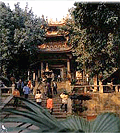 Although all are serious and solumn in appearance, each is distinctly different from another. The temple attracts a large number of pilgrims at home and from abroad. The excellent craftsmanship of the Thousand-handed Guanyin is marked by its thousand hands and thousand eyes and glistening golden colour. As to the Pavilion where Buddhist scriptures are kept, it has a rich collection of the historical articles of Buddhism. such as classics, statues of Buddhas, bronze bells from the Song Dynasty, calligraphic works and paintings from the ancient times. Among them, “Intriguing Lotus Scripture” written in blood in the Wanli period of the Ming Dynasty and the statue of Guanyin in white porcelain, a masterpiece of He Chaosong, are most valuable.
Although all are serious and solumn in appearance, each is distinctly different from another. The temple attracts a large number of pilgrims at home and from abroad. The excellent craftsmanship of the Thousand-handed Guanyin is marked by its thousand hands and thousand eyes and glistening golden colour. As to the Pavilion where Buddhist scriptures are kept, it has a rich collection of the historical articles of Buddhism. such as classics, statues of Buddhas, bronze bells from the Song Dynasty, calligraphic works and paintings from the ancient times. Among them, “Intriguing Lotus Scripture” written in blood in the Wanli period of the Ming Dynasty and the statue of Guanyin in white porcelain, a masterpiece of He Chaosong, are most valuable. 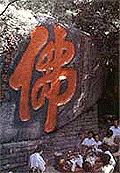 In the temple are preserved many inscriptions, among which the stone inscriptions written by Chen Di and Sheng Yourong in the Wanli period of the Ming Dynasty and the one on a stone stele written by Emperor of the Kangxi period of the Qing Dynasty are most famous. Behind the temple, inscribed on the wall of a rock is a large word “Buddha” which is 4.66 metres in height and 3.33 metres in width. And farther behind, high up on the mountain stands a screen of five peaks coloured by green trees and bamboos and marked by serene valleys and rocks of pleasing shapes. They are called “Five Old Gentlemen Reaching the Clouds,” and are one of the eight grand sights of Xiamen. Coming to the top, you not only have a view of the mountain undulating in the wind, but also the view of the sea surging in the distance.
In the temple are preserved many inscriptions, among which the stone inscriptions written by Chen Di and Sheng Yourong in the Wanli period of the Ming Dynasty and the one on a stone stele written by Emperor of the Kangxi period of the Qing Dynasty are most famous. Behind the temple, inscribed on the wall of a rock is a large word “Buddha” which is 4.66 metres in height and 3.33 metres in width. And farther behind, high up on the mountain stands a screen of five peaks coloured by green trees and bamboos and marked by serene valleys and rocks of pleasing shapes. They are called “Five Old Gentlemen Reaching the Clouds,” and are one of the eight grand sights of Xiamen. Coming to the top, you not only have a view of the mountain undulating in the wind, but also the view of the sea surging in the distance. As one of the four major scenic spots in Xiamen, Jimei enjoys a long-term fame for its tourists attractions like Turtle Garden ,Returnees Garden and the former residence of Mr. Tan Kah-Kee. Jimei is a small town on the other side of the bank facing notth Xiamen Island. With Gaoji Causeway and Xingji Causeway meeting there, Jimei becomes the sole gateway into Xiamen. Jimei is also the hometown of Mr. Tan Kah-Kee, a famous overseas Chinese leader who devoted homself wholly to the education cause. He had started various schools in the town, including Jimei Normal School, Jimei Navigation Institute, Xiamen Aquatic Products Technical Institute and Agriculture School besides Jimei Kindergarden, Jimei Primary School and Jimei Middle School. Equipped with Science Hall, library and hospital, these schools brought the town the name “Jimei School Village” which is renowned at home and abroad. The Turthe Gardeb was built during Mr. Tan Kah-Kee’s lifetime and later was chosen as the place where his grave was to be laid. Mr. Tan Kah-Kee’s residence was turned into a memorial hall and the Returnees Garden with Mr.Tan Kah-Kee’s bronze statue in it was built in his memory. In Jimei, there is still the relics where Zhen Chenggong had drilled his soldiers and the ruins of old Jimei Village — Yenping Old Fort. The Turtle Garden was constructed in 1950 by Mr. Tan Kah-Kee on the former site of “Turtle Head Palace” from which came its present name.In the centre of the garden is the Jimei Liberation Monument with an inscription by Mao Zedong on the front and a tablet record written by Mr.Tan Kah-Kee on the back.The stone foundation of the monument consists of two stages. The lower stage has eight steps ,signifying the eight-year Anti-Japanese War; the upper stage is composed of three steps, symbolizing the three year Liberation War. They are telling the later generations that victories were hard-won and therefore should be cherished. The foundation of the monument is surrounded by gray jade carvings and relief sculptures polished with great care,embodying a concentrated reflection of exquisite workmanship and a unique style of south Fujian stone carving art. The former residence of Mr.Tan Kah-Kee is situated on Jiageng Road in the town of Jimei.It is still keeping its old looks to be visited and pondered. Mr.Tan Kah-kee was living frugally all his life. No one can keep unmoved when they see how
As one of the four major scenic spots in Xiamen, Jimei enjoys a long-term fame for its tourists attractions like Turtle Garden ,Returnees Garden and the former residence of Mr. Tan Kah-Kee. Jimei is a small town on the other side of the bank facing notth Xiamen Island. With Gaoji Causeway and Xingji Causeway meeting there, Jimei becomes the sole gateway into Xiamen. Jimei is also the hometown of Mr. Tan Kah-Kee, a famous overseas Chinese leader who devoted homself wholly to the education cause. He had started various schools in the town, including Jimei Normal School, Jimei Navigation Institute, Xiamen Aquatic Products Technical Institute and Agriculture School besides Jimei Kindergarden, Jimei Primary School and Jimei Middle School. Equipped with Science Hall, library and hospital, these schools brought the town the name “Jimei School Village” which is renowned at home and abroad. The Turthe Gardeb was built during Mr. Tan Kah-Kee’s lifetime and later was chosen as the place where his grave was to be laid. Mr. Tan Kah-Kee’s residence was turned into a memorial hall and the Returnees Garden with Mr.Tan Kah-Kee’s bronze statue in it was built in his memory. In Jimei, there is still the relics where Zhen Chenggong had drilled his soldiers and the ruins of old Jimei Village — Yenping Old Fort. The Turtle Garden was constructed in 1950 by Mr. Tan Kah-Kee on the former site of “Turtle Head Palace” from which came its present name.In the centre of the garden is the Jimei Liberation Monument with an inscription by Mao Zedong on the front and a tablet record written by Mr.Tan Kah-Kee on the back.The stone foundation of the monument consists of two stages. The lower stage has eight steps ,signifying the eight-year Anti-Japanese War; the upper stage is composed of three steps, symbolizing the three year Liberation War. They are telling the later generations that victories were hard-won and therefore should be cherished. The foundation of the monument is surrounded by gray jade carvings and relief sculptures polished with great care,embodying a concentrated reflection of exquisite workmanship and a unique style of south Fujian stone carving art. The former residence of Mr.Tan Kah-Kee is situated on Jiageng Road in the town of Jimei.It is still keeping its old looks to be visited and pondered. Mr.Tan Kah-kee was living frugally all his life. No one can keep unmoved when they see how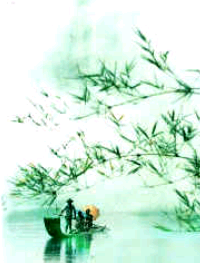 Originating in the Wuyi Natural Reserve and flowing through mountain valleys. The Nine-Twist Stream runs nine kilometers and has 9 twists in its course. The clean water moving past rocks and cliffs combines with the exotic peaks crowned by green groves presenting a real-life traditional Chinese painting.
Originating in the Wuyi Natural Reserve and flowing through mountain valleys. The Nine-Twist Stream runs nine kilometers and has 9 twists in its course. The clean water moving past rocks and cliffs combines with the exotic peaks crowned by green groves presenting a real-life traditional Chinese painting.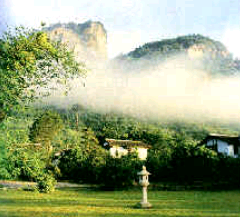 Because this peak is shaped like an ancient Chinese majestic official’s hat, people call it Great King Peak. It sits commandingly at the mouth of the Nine-Twist Stream, southeast of the Wuyi Palace. Standing on the 530-meter peak, it greets tourists as they set out their trip. At top of the peak old trees grow thick, while on the eastern side you can see Immortal-Transformation Cave(shenzhen-dog) . According to Zhuxi, the great Confucianist, King Wuyi lived in this cave. A deep split extending from the top of the peak into its bottom is said to be the place where a special envoy in the Song Dynasty worshiped King Wuyi.
Because this peak is shaped like an ancient Chinese majestic official’s hat, people call it Great King Peak. It sits commandingly at the mouth of the Nine-Twist Stream, southeast of the Wuyi Palace. Standing on the 530-meter peak, it greets tourists as they set out their trip. At top of the peak old trees grow thick, while on the eastern side you can see Immortal-Transformation Cave(shenzhen-dog) . According to Zhuxi, the great Confucianist, King Wuyi lived in this cave. A deep split extending from the top of the peak into its bottom is said to be the place where a special envoy in the Song Dynasty worshiped King Wuyi.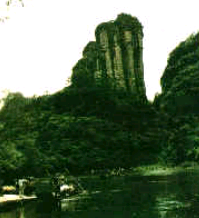 Located south of the second twist and facing a big deep pool, this peak looks like a girl standing gracefully. The rock in Jade Maiden Peak appears skin-smooth while the dewy-green grass and tree sat the top suggest a girl’s hair. As we look at the peak’s reflection in the water, we can imagine a graceful, deep-in-thought, traditional girl, wishing for a bright future. This peak symbolizes the beauty of Wuyi scenery.
Located south of the second twist and facing a big deep pool, this peak looks like a girl standing gracefully. The rock in Jade Maiden Peak appears skin-smooth while the dewy-green grass and tree sat the top suggest a girl’s hair. As we look at the peak’s reflection in the water, we can imagine a graceful, deep-in-thought, traditional girl, wishing for a bright future. This peak symbolizes the beauty of Wuyi scenery.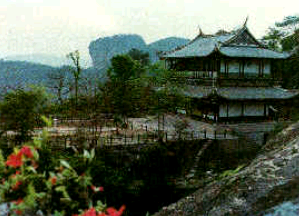 The Tianyouguan Hotel
The Tianyouguan Hotel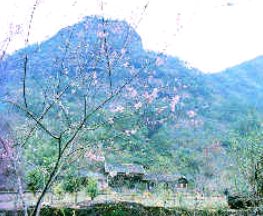 The Beautiful Scene of Taoyuan Cave
The Beautiful Scene of Taoyuan Cave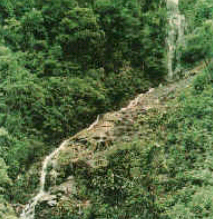 This nature reserve is located at the common boundary point of Wuyishan City, Jianyang and Guanze Counties. It extends 52 km. from north to south, and 22km from east to west, enclosing an area of 570 square km and the mountains here are steep and heavily forested. Abundant rainfall and warm, humid weather give it a typical moderate sub-tropical climate, this is one of the five key nature reserves in China.
This nature reserve is located at the common boundary point of Wuyishan City, Jianyang and Guanze Counties. It extends 52 km. from north to south, and 22km from east to west, enclosing an area of 570 square km and the mountains here are steep and heavily forested. Abundant rainfall and warm, humid weather give it a typical moderate sub-tropical climate, this is one of the five key nature reserves in China.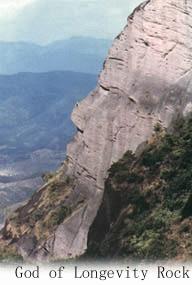 Guangzhi Mountain lies in the east of Liancheng County, Fujian Province, which is 1.5 kilometres far from the county town and stands upright. The scenic areas cover 123 square kilometres in circumference. Its highest peak looks like a crown worn by an ancient judge(in Chinese, the crown is called Guangzhi).
Guangzhi Mountain lies in the east of Liancheng County, Fujian Province, which is 1.5 kilometres far from the county town and stands upright. The scenic areas cover 123 square kilometres in circumference. Its highest peak looks like a crown worn by an ancient judge(in Chinese, the crown is called Guangzhi).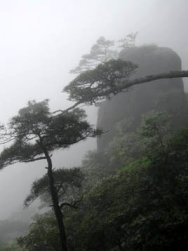 Huangshan (Yellow Mountain) is the name of the 72 peaks range lying in the south of Anhui province and have been designated as a national park and declared a World Natural and Cultural Heritage area by UNESCO.
Huangshan (Yellow Mountain) is the name of the 72 peaks range lying in the south of Anhui province and have been designated as a national park and declared a World Natural and Cultural Heritage area by UNESCO. Beautiful are the mountains: they constantly change their appearance, graceful, wondrous, forever fresh and unconventional. There stand the towering peaks, but in an instant they will turn into islands above a sea of clouds, and the pine trees growing out of the crevices will look as if they had taken root in the clouds, reminding the tourists of the “jade foliage on golden branches” in the legend. As the year passes from one season to another, as the weather changes from rain to shine, as the sun sets and the moon rises, the mountain changes, continually taking on new looks. Even if you visit The Yellow Mountains a thousand times, each time you will discover new beauties and enjoy new experiences.
Beautiful are the mountains: they constantly change their appearance, graceful, wondrous, forever fresh and unconventional. There stand the towering peaks, but in an instant they will turn into islands above a sea of clouds, and the pine trees growing out of the crevices will look as if they had taken root in the clouds, reminding the tourists of the “jade foliage on golden branches” in the legend. As the year passes from one season to another, as the weather changes from rain to shine, as the sun sets and the moon rises, the mountain changes, continually taking on new looks. Even if you visit The Yellow Mountains a thousand times, each time you will discover new beauties and enjoy new experiences.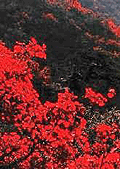 In the 10th year of the Qianlong Era of the Qing Dynasty, Jingyi Garden was set up here which consists of 28 scenic sports and was known as the famous “three hills and five parks” in the suburbs of the city. In 1956 the Garden first opened to the public. Three best routes are recommended to the tourists to climb the hill for sightseeing and each winds through respectively the northern, the middle, the southern part of the hill.
In the 10th year of the Qianlong Era of the Qing Dynasty, Jingyi Garden was set up here which consists of 28 scenic sports and was known as the famous “three hills and five parks” in the suburbs of the city. In 1956 the Garden first opened to the public. Three best routes are recommended to the tourists to climb the hill for sightseeing and each winds through respectively the northern, the middle, the southern part of the hill. 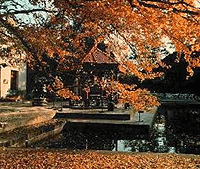 Touring through the hill takes about 2 hours. The Fragrant Hills boasts of its beautiful landscape and tourists through out the four seasons. The most beautiful sight here is the maple leaves. They grow on the smoke trees and turn red after frosts in late autumn. Then all the hills are attired in these maple leaves which seem to reach the rosy clouds in the sky.
Touring through the hill takes about 2 hours. The Fragrant Hills boasts of its beautiful landscape and tourists through out the four seasons. The most beautiful sight here is the maple leaves. They grow on the smoke trees and turn red after frosts in late autumn. Then all the hills are attired in these maple leaves which seem to reach the rosy clouds in the sky.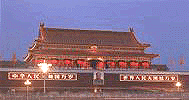 Later renamed “Tiananmen”, it was renovated repeatedly. Also called the “National Gate”, it was one from which the emperor came in and out when be got married, personally went on an ex-pedition, worshipped heaven at the Temple of Heaven, attended farming ceremonies at Xiannongtan. On the grand occasions when the emperor was enthroned and the empress set up, the ceremonies to issue imperial edict were conducted at Tianan-men. First, the im-perial edict was placed in a tray, held by the Minister of Rites from the Hall of Supreme Harmony through the Gate of Supreme Harmony.
Later renamed “Tiananmen”, it was renovated repeatedly. Also called the “National Gate”, it was one from which the emperor came in and out when be got married, personally went on an ex-pedition, worshipped heaven at the Temple of Heaven, attended farming ceremonies at Xiannongtan. On the grand occasions when the emperor was enthroned and the empress set up, the ceremonies to issue imperial edict were conducted at Tianan-men. First, the im-perial edict was placed in a tray, held by the Minister of Rites from the Hall of Supreme Harmony through the Gate of Supreme Harmony.  Then,the tray was carried in an imperial kiosk onto the Tiananmen rostrum, right in the centre of which an official read the edict. After that,a wooden phoenix with the edict in her mouth, descended slowly from the rostrum. Princes,dukes,ministers, cholars and gen-tlemen were all ears on their knees in the square. An offical from the Ministry of Rites took over the and sent it to the Ministry,where the edict,transcribed on yellow papers, was released to country. This is what is known as “Golden Phoenix Promulgating Imperial Edict”.
Then,the tray was carried in an imperial kiosk onto the Tiananmen rostrum, right in the centre of which an official read the edict. After that,a wooden phoenix with the edict in her mouth, descended slowly from the rostrum. Princes,dukes,ministers, cholars and gen-tlemen were all ears on their knees in the square. An offical from the Ministry of Rites took over the and sent it to the Ministry,where the edict,transcribed on yellow papers, was released to country. This is what is known as “Golden Phoenix Promulgating Imperial Edict”.